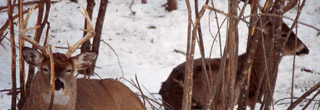Theoretically, stand hunting is the very best way to hunt whitetails. This is because while stand hunting, you are stationary, therefore less visible to the motion-sensitive eyes of deer, less apt to make telltale sounds and not laying down ruinous human trail scents and equally ruinous human airborne scents that spread downwind throughout a lengthening area 200 yards wide.
The trouble is, stand hunters must (or should) walk on foot to get to a stand site. While doing this, they are not motionless, not usually silent and they are then laying down a path of persistent human trail scents, all the while emitting an invisible cloud of airborne human odors that temporarily permeates an expanse 200 yards wide along the entire extent of the stand site approach trail – a rather imposing expanse of potentially ruinous scents indeed. To make matters worse, upon arriving at a stand site, most stand hunters are not inclined to remain motionless or silent very long. Many even begin banging antlers together, blowing on noisemakers and/or releasing scents into the air that most mature whitetails now realize are dangerous if accompanied by human odors.
As a rule these days, between the first few minutes of using a stand site and the final minutes of the third consecutive half-day of hunting at the same stand site, virtually all stand hunters are discovered and identified by the doe and her young (including yearlings) that live within their surrounding 125-acre doe home range, the 2-3 mature bucks that live in overlapping home ranges within the surrounding 300 acres or so in your half of a square mile and the largest buck (the dominant breeding buck) that owns the entire surrounding square mile. The tipoff is usually a dark human silhouette that moves, a uniquely human sound such as a cough or metallic click and/or a complex mixture of odors only characteristic of human hunters, unexpectedly or expectedly detected by deer passing unseen within 200 yards downwind. Whitetails that have survived two or more hunting seasons generally avoid a newly discovered stand site being used by a hunter throughout the balance of the hunting season.
Many hunters believe elevated stands and products claimed to eliminate odors of hunters make it impossible for whitetails to smell them. Actually, recent experiments with K-9 dogs used by law enforcement officers in Minnesota have proven any product available today that is claimed to eliminate or cover odors of deer hunters does not in the least fool noses of dogs. It has also been proven odoriferous molecules emitted by hunters, their clothing and hunting gear drop steeply toward the ground from any stand height. This means though tree stands and such products can provide important benefits while hunting whitetails, they cannot keep extremely sensitive noses of downwind whitetails from readily identifying stand hunters (and all other deer hunters).
With few exceptions, therefore, it no longer makes sense to waste valuable hunting time at one stand site throughout a hunting season. When hunting older bucks, in fact, it is generally a waste of time to use one stand longer than 1/2 to 2 days per hunting season. Ideally, then, especially when a mature buck is your intended quarry, you should never begin a hunting season with less than one well-located stand site (elevated or ground level) to use for every 1/2 to 2 days you plan to hunt My sons and I select one for each half day we plan to hunt. Many are natural, ground level blinds intended for use with a backpacked stool that require little or no preparation. First-time-used stand sites are generally our most productive for taking mature bucks (see photo).

